How to Monitor and Adjust TPN for Optimal Patient Health
Introduction to TPN Monitoring and Adjustment
Total Parenteral Nutrition (TPN) is an essential therapy for patients unable to meet their nutritional needs through oral or enteral routes. Successful TPN management relies on diligent monitoring and precise adjustments to optimize patient outcomes while minimizing complications. This article explores comprehensive strategies for monitoring, key parameters to assess, best practices for therapy adjustment, and the multidisciplinary approaches vital to safe and effective TPN use.
Understanding TPN Guidelines and Solutions
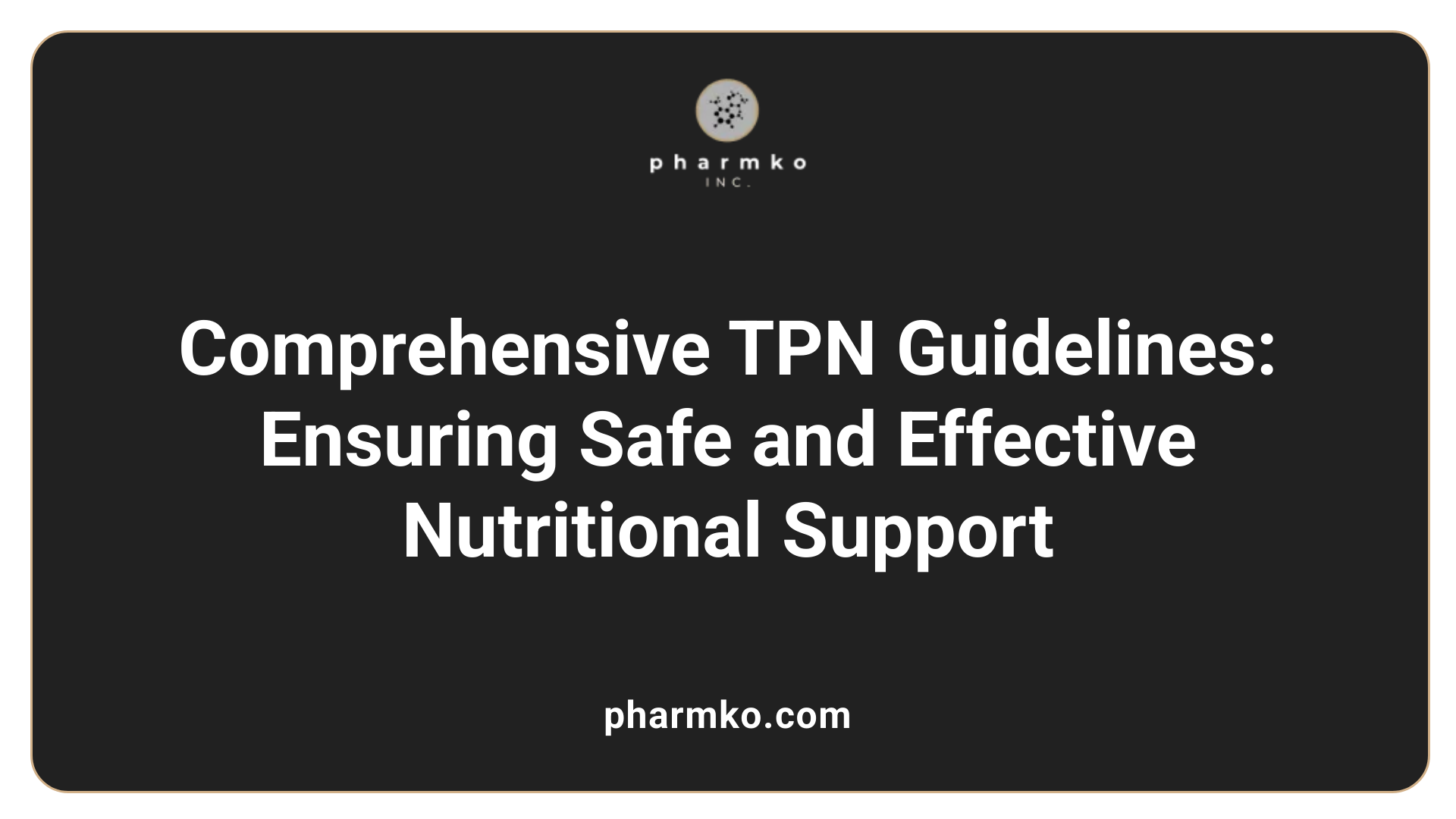 What information is available regarding TPN guidelines and solutions?
What information is available regarding TPN guidelines and solutions?
Guidelines and solutions for Total Parenteral Nutrition (TPN) are well-documented through numerous sources, including authoritative PDFs, medical institutional protocols, and guidelines issued by professional organizations like ESPEN (European Society for Clinical Nutrition and Metabolism). These resources provide comprehensive instructions on when and how to initiate TPN, tailor formulations to meet individual patient needs, and carry out safe administration practices.
TPN solutions are specifically customized based on factors such as a patient’s nutritional requirements, medical history, biochemical data, and overall health condition. The formulations typically include carbohydrates (primarily dextrose), amino acids for protein, lipids for energy and organ support, and a blend of vitamins and minerals. Proper preparation involves sterile techniques, with mixtures prepared by specialists and stored under proper refrigeration, then brought to room temperature before use.
The protocols emphasize a multidisciplinary approach, involving doctors, nurses, dietitians, and pharmacists. Monitoring plays a crucial role; regular assessment of biochemical parameters (like electrolytes, liver function, and blood glucose), clinical signs of complications, and catheter site observation are essential to ensure safety and effectiveness. This includes surveillance for electrolyte imbalances, infections, liver issues such as cholestasis, or metabolic disturbances.
Patient education is integral, covering aseptic handling, recognizing signs of complications, and understanding the importance of compliance. Adjustments to therapy are made based on ongoing assessments, with particular attention to preventing overfeeding and refeeding syndrome. Regular blood parameters are checked—initially daily, then weekly or monthly once stabilized—to guide modifications. Overall, these guidelines enable healthcare providers to optimize TPN therapy, ensuring nutritional adequacy while minimizing risks.
Routine Monitoring of TPN Patients
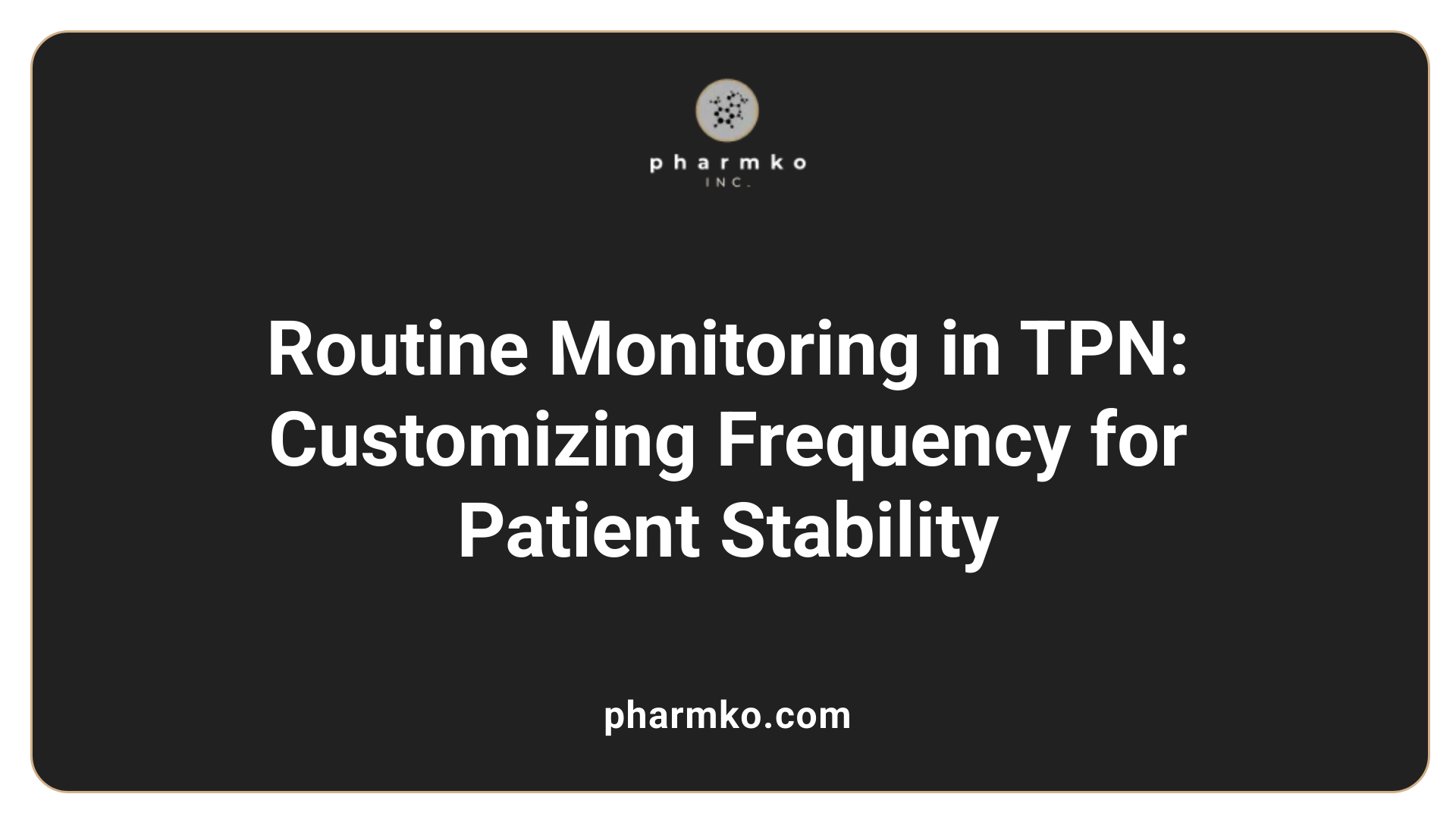
What factors influence the frequency of monitoring during TPN therapy?
The frequency of monitoring patients on total parenteral nutrition (TPN) depends on several factors. Initially, during the stabilization phase when a patient starts TPN, more frequent assessments are vital. This includes daily or multiple times per week checks of essential laboratory parameters such as electrolytes, liver function tests, and blood glucose levels. These frequent checks are necessary to detect and correct metabolic abnormalities like electrolyte imbalances, hyperglycemia, or signs of refeeding syndrome.
As the patient stabilizes over time and no formulation changes are needed, the monitoring schedule can be relaxed. For stable patients with no recent issues, tests can be spaced out to every 2 to 7 days initially, and then extended to every 1 to 4 weeks in long-term, stable cases. Continued vigilance is important, especially if the patient has underlying liver issues or if complications like cholestasis or electrolyte disturbances develop.
Risk factors such as liver dysfunction, electrolyte imbalances, or infections influence more frequent checks. Patients at higher risk—such as children, critically ill individuals, or those with complex medical histories—require tailored, often more intensive, monitoring schedules. In addition, clinical signs like weight changes, skin integrity, or infection symptoms guide the frequency of assessment.
Overall, the monitoring plan must balance the need for early detection of potential complications with the practicality of testing intervals, guided by established guidelines, patient response, and clinician judgment.
Key Parameters to Monitor in TPN Therapy
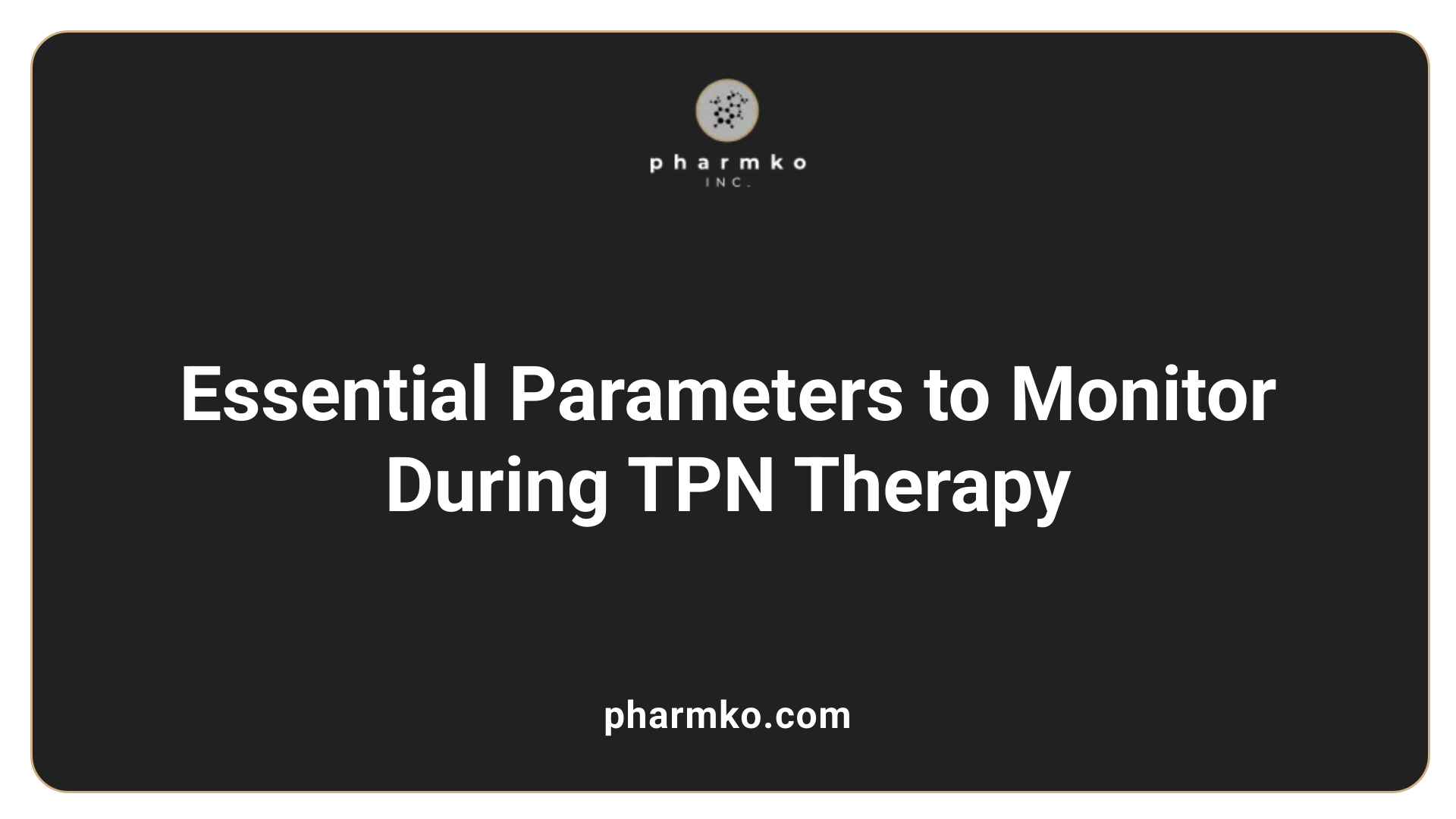
What are the key parameters to monitor during TPN therapy?
Monitoring during Total Parenteral Nutrition (TPN) is crucial to ensure patient safety and optimal nutritional support. It involves both clinical assessments and laboratory tests.
Clinically, healthcare providers regularly evaluate vital signs such as temperature, heart rate, blood pressure, and respiratory rate. Monitoring fluid balance is vital to prevent overload or dehydration, achieved by recording intake and output—especially fluid from IV fluids, medications, and TPN infusions—every eight hours. Observing the catheter insertion site for signs of infection or complications is also essential.
Assessments of nutritional status include measuring body weight weekly, calculating BMI, and examining physical markers like mid-arm circumference, skin fold thickness, grip strength, and overall skin integrity.
Biochemical monitoring focuses on several laboratory parameters. Electrolytes such as sodium, potassium, chloride, magnesium, phosphate, and calcium should be checked frequently—initially daily or every few days—to detect imbalances that may require adjustments in TPN electrolyte content.
Liver function tests—including bilirubin and liver enzymes (ALT, AST, ALP, GGT)—are monitored regularly to detect liver stress or cholestasis, especially in long-term TPN patients.
Blood glucose levels require close oversight—initially four times daily—to manage hyperglycemia, a common complication. Adjustments in insulin dosing may be made based on these readings.
Additional markers include complete blood count (CBC) to identify infections or anemia, serum cholesterol and triglycerides to assess lipid tolerance, and bone profile tests to monitor mineral status.
Monitoring also involves evaluating the catheter site, GI function, medication needs, and signs of metabolic or infectious complications to guide timely interventions.
Frequency of testing varies; during initial stabilization, daily testing is common, while once stable, every 1 to 2 weeks may suffice. If the patient’s condition changes, more frequent assessments become necessary.
Incorporating all these parameters helps healthcare providers tailor TPN therapy, minimize risks, and promote patient recovery and well-being.
Preventing and Managing TPN-Related Complications
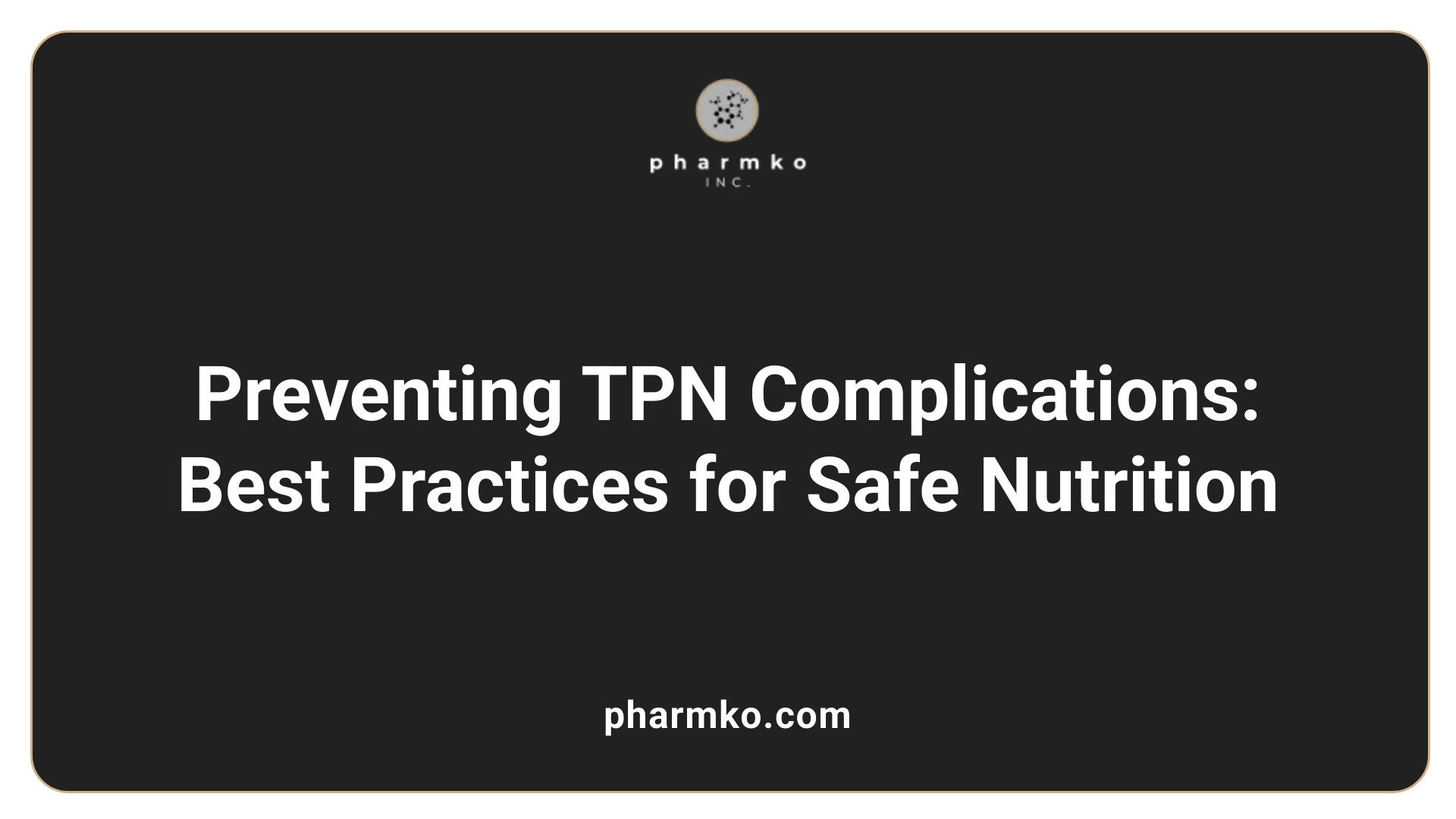
What are the common complications associated with TPN therapy?
Total Parenteral Nutrition (TPN) is a vital therapy for patients unable to meet nutritional needs orally or enterally. However, it carries risks of various complications that require vigilant monitoring and proactive management.
One of the most immediate concerns is infection. Central line-associated bloodstream infections are a significant threat and necessitate strict aseptic techniques during catheter insertion, care, and maintenance. Maintaining the catheter site dry and protected from water exposure is essential to prevent microbial entry.
Metabolic disturbances are also prevalent. Patients on TPN may experience fluctuations in blood glucose levels, leading to hyperglycemia or hypoglycemia. Regular blood glucose monitoring is necessary, often four times daily initially, with insulin adjustments made as needed. Electrolyte imbalances such as hypokalemia, hypophosphatemia, or hypomagnesemia may develop, especially during refeeding or if losses are not compensated. Trends in serum electrolytes should guide appropriate adjustments in the TPN composition.
Long-term TPN use can lead to liver-related issues like cholestasis, fatty liver changes, and, in some cases, metabolic bone disease. These conditions highlight the importance of routine liver function tests (twice weekly initially, then less frequently once stable) and liver imaging when indicated.
Catheter-related problems, including dislodgement, thrombosis, or occlusion, can interrupt therapy and must be quickly identified and addressed. Proper line care, securement, and regular clinical assessment of the insertion site are fundamental.
Finally, nutritional imbalances such as hyperlipidemia or deficiencies in vitamins and minerals can occur if monitoring and adjustments are inadequate. Weekly laboratory evaluations—including lipid profiles, trace elements, and vitamin levels—help tailor the TPN to the patient's evolving needs.
Overall, effective management of TPN complications hinges on multidisciplinary oversight—regular biochemical testing, clinical assessment, and prompt response to abnormal findings. Education of healthcare providers and patients is also vital in recognizing early signs and responding appropriately.
What strategies can be implemented to prevent TPN complications?
- Use strict aseptic techniques during line insertion and care
- Regularly monitor blood glucose and electrolytes
- Replace TPN bags and tubing according to guidelines to prevent contamination
- Maintain meticulous line care and securement
- Conduct routine liver function assessments and imaging
- Adjust nutritional content based on ongoing laboratory data
- Educate patients and caregivers on infection signs and line care practices
By following these practices, health teams can minimize risks and improve outcomes for patients on TPN.
Best Practices for TPN Administration and Adjustment
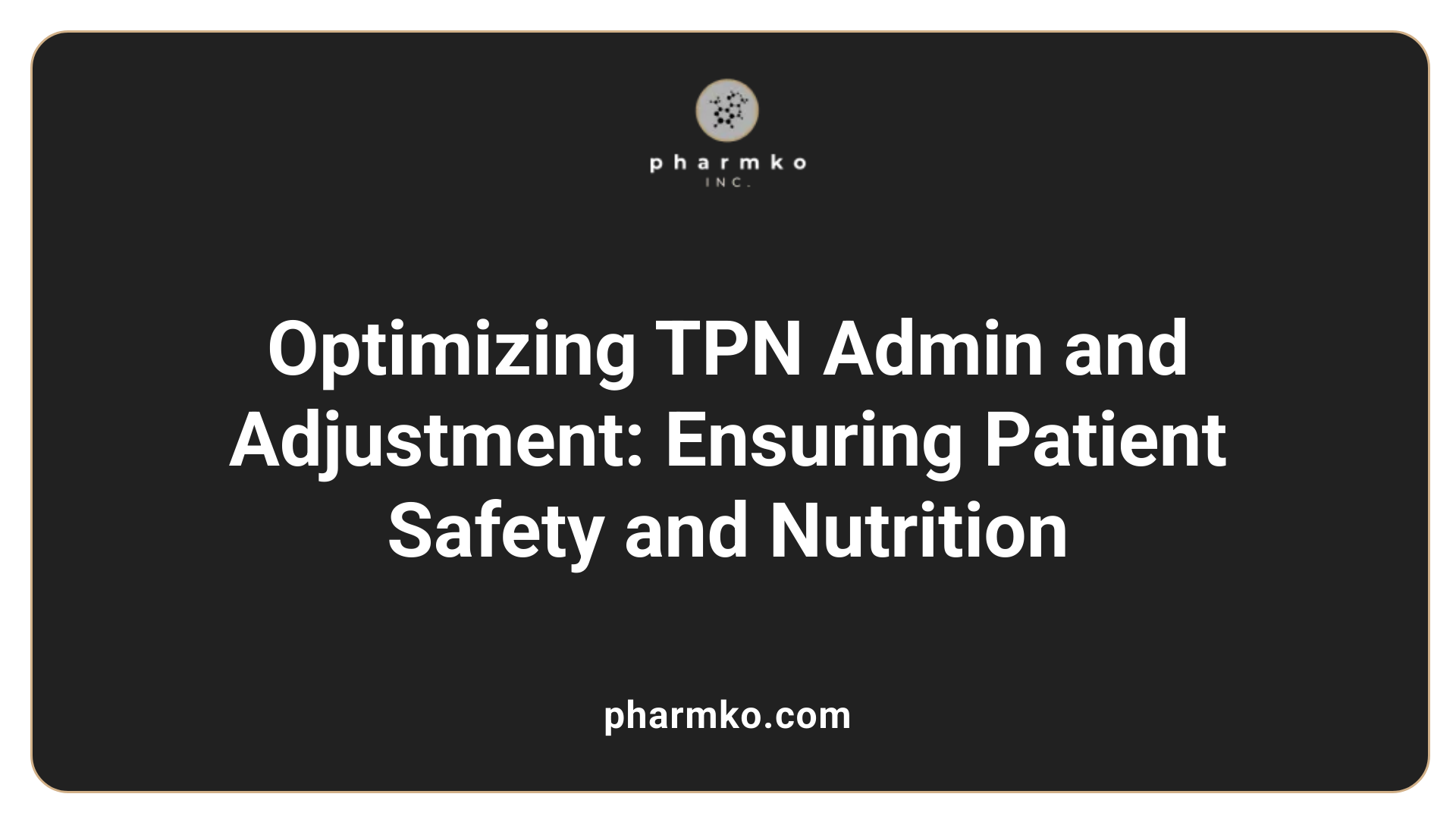
What are the best practices for TPN administration and adjustment?
Administering Total Parenteral Nutrition (TPN) safely and effectively requires meticulous attention to detail. The process begins with careful calculation and personalization of the nutrient formulation based on the patient's specific needs. This involves assessing factors such as age, weight, clinical condition, metabolic demands, and lab results.
Preparation of TPN solutions must adhere to strict aseptic techniques to prevent infections. This includes sterilizing all equipment, disinfecting injection ports, and ensuring proper handling when adding medications or vitamins. The infusion should be conducted with a programmable pump, which guarantees consistent flow rates and minimizes the risk of air embolism or infiltration.
Monitoring the patient continuously is crucial. Vital signs, blood glucose levels, and signs of infection or catheter site issues should be checked regularly. Blood work, such as electrolytes, liver function tests, blood glucose, and renal markers, should be reviewed frequently—initially daily or every few days—and adjustments made accordingly.
Adjustments to the TPN regimen are often necessary to match the patient’s evolving needs. This may involve modifying calorie content, electrolyte concentrations, or adding insulin for blood sugar management. Any changes should be based on recent lab results and clinical assessment to optimize nutritional status and prevent complications like overfeeding or refeeding syndrome.
In summary, adhering to established guidelines, maintaining strict aseptic techniques, and performing regular evaluations form the cornerstone of best practices for TPN administration and adjustment. These strategies help support recovery, reduce risks, and promote optimal patient outcomes.
Role of Nursing in TPN Management
What are the key parameters to monitor during TPN therapy?
Nursing staff play a vital role in the safe administration and management of total parenteral nutrition (TPN). Monitoring involves a comprehensive approach combining clinical observations and laboratory assessments.
Clinically, nurses assess vital signs, body weight, fluid balance, and nutritional markers such as arm circumference, skin fold thickness, grip strength, and overall physical condition. These assessments help determine the patient’s nutritional status and detect early signs of dehydration, fluid overload, or malnutrition.
Laboratory parameters are equally important. Regular checks include electrolytes — sodium, potassium, chloride, magnesium, phosphate, and calcium — to identify imbalances that can impact organ function. Liver function tests, complete blood count, blood glucose levels, and infection markers are also monitored to detect metabolic disturbances, infections, or liver stress.
Blood glucose monitoring is critical, especially in insulin management, with frequent testing (initially four times daily) to prevent hyperglycemia or hypoglycemia. Lipid profiles such as cholesterol and triglycerides are reviewed initially and less frequently once stable.
Monitoring access site conditions, signs of infection, and GI function are integral parts of the routine checks. Any abnormal findings—such as redness, swelling, or discharge at catheter sites, or symptoms of infection—must be promptly addressed.
These ongoing evaluations enable nurses to make informed adjustments to the TPN formulation, including electrolyte replenishment, insulin administration, or modifying nutrient components. Maintaining strict aseptic technique during all procedures is essential to prevent infections.
In summary, a combination of clinical inspection and routine blood work underpins effective TPN management. This vigilant approach ensures that nutritional therapy supports recovery while minimizing risks of complications.
Monitoring and Adjustment Procedures
How should TPN be monitored to ensure patient safety and optimal outcomes?
Monitoring patients on Total Parenteral Nutrition (TPN) involves a combination of clinical assessments, laboratory evaluations, and careful observation of physical signs. Initially, frequent blood tests are essential to catch any metabolic imbalances early. These tests include checking electrolytes such as sodium, potassium, magnesium, phosphate, and calcium to prevent or manage disturbances that could impair organ function.
Blood glucose levels must be monitored regularly—initially multiple times a day—to detect hyperglycemia or hypoglycemia and to guide insulin adjustments if needed. Liver function tests, including bilirubin and liver enzymes, help identify hepatic stress or cholestasis, common long-term complications.
Fluid intake and output should be recorded diligently, with special attention to prevent fluid overload or dehydration. Vital signs and catheter site assessments are conducted frequently, especially during initial therapy or if there are signs of infection or line complications.
Nutritional parameters such as daily weight, body measurements, and clinical indicators like skin integrity and strength provide ongoing feedback about nutritional adequacy.
Strict aseptic techniques in line care are critical to avoiding catheter-related bloodstream infections. Regular inspection of the IV site for redness, swelling, or discharge is vital for early infection detection.
Laboratory and clinical data are reviewed routinely—initially every 1-2 days during starting phases, then weekly once stable. Adjustments to TPN formulations are made based on trends observed in these data, including changing electrolyte content, glucose levels, or lipid composition.
This comprehensive approach ensures that nutritional needs are met without causing harm, optimizing recovery and minimizing complications during TPN therapy.
Patient Education and Home TPN Care
What are the best practices for TPN administration and adjustment?
Effective management of TPN at home requires careful preparation, consistent monitoring, and prompt adjustments. Patients and caregivers should be trained extensively on how to prepare the TPN bag, including adding medications or vitamins using sterile techniques and ensuring the solution’s stability and correct temperature before administration.
The use of a reliable IV pump is crucial for accurate infusion rates, and verifying the correct setup every time helps prevent complications like overdosing or underdosing. Maintaining strict aseptic technique during connection and disconnection reduces the risk of infections, which are a common concern with long-term central line use.
Monitoring should include regular assessment of vital signs, blood glucose, electrolytes, and signs of infection or catheter issues. Blood sugar should be checked at least four times daily initially, adjusting insulin and dextrose content as needed.
Clinicians must tailor the nutrient formulation according to the patient’s ongoing needs, which are determined through periodic lab tests and clinical evaluations. Adjustments are made based on trends in blood chemistry and overall health status to ensure nutritional adequacy without causing metabolic disturbances.
This comprehensive approach, combining meticulous preparation, vigilant monitoring, and timely adjustments, helps ensure the safety and effectiveness of home TPN therapy, aiding patients in maintaining their health and quality of life.
Long-term TPN Management Challenges
Monitoring for liver and metabolic complications is an essential aspect of long-term parenteral nutrition (PN). Patients receiving TPN over extended periods are at risk for conditions like fatty liver, cholestasis, and metabolic bone disease. Regular assessment involves liver function tests, such as bilirubin, ALT, AST, and alkaline phosphatase levels, conducted biweekly or weekly initially, then less frequently if stable. Detecting early signs of liver stress allows clinicians to adjust the TPN formulation, reduce overfeeding, and manage contributing factors like infections or drug use.
Monitoring micronutrient status is also crucial in long-term TPN care. Despite the routine inclusion of vitamins and minerals in the PN formulation, deficiencies or excesses can occur over time. Regular lab checks—including serum levels of trace elements like zinc, copper, manganese, and vitamins such as vitamin D and B12—help ensure adequacy. These assessments are typically done every 3–6 months but may be more frequent if abnormalities are suspected or if the patient has malabsorption issues or ongoing organ dysfunction.
Transitioning to enteral or oral nutrition is a key step in long-term TPN management. When the patient’s gastrointestinal function improves and can tolerate increased oral intake, gradually reducing TPN is advisable. The transition should happen when the patient consistently consumes over 50% of their nutritional needs without significant symptoms. Close monitoring during this period helps prevent refeeding syndrome and nutritional imbalances. The goal is to eventually wean off TPN entirely while maintaining adequate nutritional intake through the gut, improving quality of life, and reducing dependence on intravenous support.
| Monitoring Aspect | Frequency | Additional Comments |
|---|---|---|
| Liver function tests | Weekly to biweekly | Adjust based on stability |
| Micronutrient levels | Every 3–6 months | Includes vitamins, trace elements |
| Nutritional status | Monthly | Weight, BMI, clinical assessments |
| Transition readiness | As tolerated | Based on GI function and oral intake |
Factors affecting monitoring frequency include patient stability, presence of complications, and individual risk factors, requiring tailored plans. Regular assessments ensure early detection of issues and support safe long-term TPN therapy, ultimately helping patients maintain optimal health and minimize adverse outcomes.
Conclusion: Pursuing Excellence in TPN Monitoring and Adjustment
Effective monitoring and precise adjustment of TPN are critical to ensuring optimal patient health outcomes. A multidisciplinary approach combining laboratory surveillance, clinical assessment, and patient education forms the foundation of safe TPN management. Regular review of biochemical parameters, vigilant infection control practices, and patient-centric strategies such as home care training are paramount. Staying vigilant for complications like metabolic disturbances and hepatic issues, and responding swiftly through tailored interventions, can significantly improve prognosis and patient quality of life. Continuous education for healthcare providers and patients alike supports ongoing excellence in TPN therapy, fostering safer environments and better nutritional results.
References
- Total Parenteral Nutrition - StatPearls - NCBI Bookshelf
- 10 Tips for Adjusting to Your Life With TPN (Total Parenteral Nutrition)
- [PDF] The Hitchhiker's Guide to Parenteral Nutrition Management for Adult ...
- Parenteral Nutrition: What it Is, Uses & Types - Cleveland Clinic
- [PDF] Navigating Home Care: Parenteral Nutrition—Part Two
- 8.8 Total Parenteral Nutrition (TPN) – Clinical Procedures for Safer ...
- [PDF] Patient Guide to Parenteral Nutrition | Option Care Health













